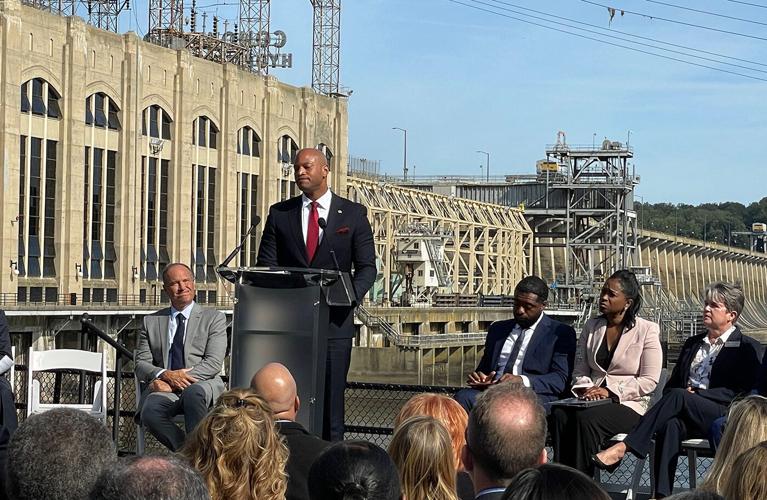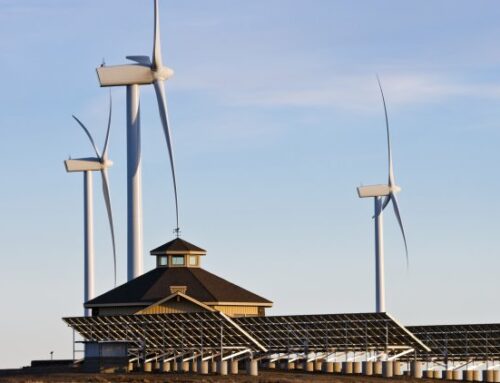Conowingo Dam Owners to Pay $340 Million for Environmental Safeguards
October 6, 2025
It took three years to build the 94-foot-high Conowingo Dam that towers above the Susquehanna River in Maryland, just 10 miles upstream from the Chesapeake Bay.
But it’s taken more than a decade for state officials, the owners of the dam and environmental groups to agree on terms for a new operating license that addresses the fish passage and water quality issues the dam creates.
They gathered at Conowingo on Oct. 2 to announce a new agreement that commits Constellation Energy Corp., which owns the dam, to spend $340 million addressing environmental issues over the 50-year life of the new license.
Maryland Gov. Wes Moore said the agreement “will lead to real improvements in water quality in the biggest tributary of the Chesapeake Bay while securing the future of one of our state’s largest clean energy producers.
“By bringing everyone to the table, we have struck an agreement that is good for the environment, good for energy production, and good for Marylanders,” Moore said.
But the agreement still needs federal sign-off before the dam is relicensed.
Maryland Gov. Wes Moore said the agreement “will lead to real improvements in water quality in the biggest tributary of the Chesapeake Bay while securing the future of one of our state’s largest clean energy producers.
“By bringing everyone to the table, we have struck an agreement that is good for the environment, good for energy production, and good for Marylanders.”

But the agreement still needs federal sign-off before the dam is relicensed.
Conowingo produces emission-free electricity but has substantial environmental impacts. It has prevented migratory fish such as shad, river herring and eels — whose populations are near historic lows — from reaching upstream habitats on the largest river on the nation’s East Coast.
Also, the reservoir behind the dam is near its holding capacity, creating conditions that can result in more sediment and nutrient pollution washing downstream and into the Bay.
The new agreement promises $340 million to address those issues, though officials said the funding would be “front-loaded” with more work in the early years. That’s an increase from $230 million pledged in a previous agreement that was tossed out by a 2022 court ruling after environmental groups charged it failed to adequately address key issues.
Conowingo can generate enough carbon-free electricity to power 165,000 homes, and it generally operates as a “peaking facility,” which means it adjusts power generation to meet high-demand periods on the energy grid.
Constellation President Joe Dominguez said the dam was called upon more than 4,200 times this year in response to peak demands. He said that reaching the agreement “tells us that we could count on this facility to be around for the next 50 years” and allow the company to plan investments that will maintain the facility and address environmental problems.
Dominguez lamented that resolving the license issue took so long but said that “the resolution to those permitting issues often requires people coming together that have different interests, that sometimes have conflicting interests, and bringing those folks together and making something good happen.”
Ted Evgeniadis, the Lower Susquehanna Riverkeeper and one of those who challenged the earlier license, said the negotiations helped produce an agreement that would benefit natural resources for the public today and for future generations.
The improvements will help fish access migration routes that have been blocked for a century and bolster the depleted population of water-filtering mussels, he noted.
“The investments spoken about today to help our fish move upriver are priceless,” Evgeniadis said. “The financial obligations to restore a critical species like freshwater mussels has been a long time coming.”
In addition, it commits money to continue studying the potential for dredging sediment that has built up in the dam’s 14-mile-long reservoir, something the riverkeepers have long promoted.
Among the funding commitments in the agreement:
- $87.6 million for pollution reduction and resiliency initiatives such as shoreline restoration, forest buffers, fish passage projects and underwater grass beds
- $77.8 million to strengthen efforts to remove trash that collects at the dam and washes downstream
- $28 million for fish and eel passage improvements and protections at the dam
- $23.3 million to build and operate a hatchery that will seed the river with mussels that help filter the water
- $18.7 million to support additional studies of the potential for dredging sediment from the dam’s reservoir
- $9.4 million to control nonnative species such as snakeheads and blue catfish
As a hydroelectric facility, Conowingo requires a license from the Federal Energy Regulatory Commission (FERC) to operate. To get a license, its owner must address environmental issues and the state must certify that its water quality impacts are addressed. Studies to address those issues began well over a decade ago when the dam was owned by Exelon Corp.
The Maryland Department of Environment in 2018 said the utility would need to spend $172 million a year to address nutrient pollution washing downstream from the dam. Exelon sued, saying that was more money than the dam produced in a year, and eventually negotiated an out-of-court deal with the state that would provide roughly $230 million for various environmental projects.
FERC issued a new license, but Waterkeepers Chesapeake along with two of its member organizations — the Lower Susquehanna Riverkeeper and Sassafras Riverkeeper — and the Chesapeake Bay Foundation filed suit in June 2021. They said the state should not have been allowed to negotiate conditions in private that backtracked on earlier commitments.
A three-judge panel of the U.S. Court of Appeals for the District of Columbia sided with environmental groups in 2022, saying that FERC exceeded its authority by accepting a privately negotiated deal.
That led to a mediation process over the last two years between the state, Constellation and environmental groups that produced the agreement announced Oct. 2.
The agreement does not take effect until FERC issues a new license.
Search
RECENT PRESS RELEASES
Related Post




